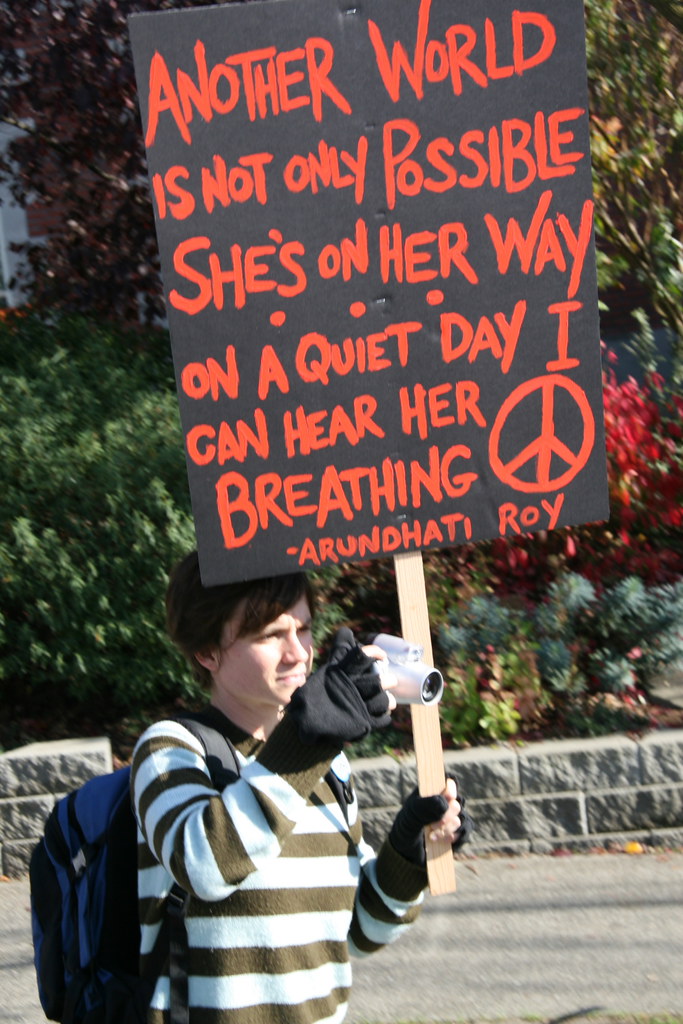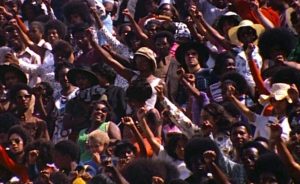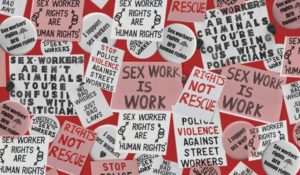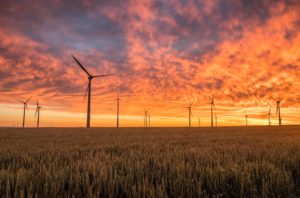It’s May! Many of us started the year off with a to-read list, or maybe you’ve just decided to make one. It doesn’t matter; it’s been an interesting five months, and we might be left rather uninspired, or we may just be looking for fresh new reads. But between the wins and the growth in movements we’ve seen, we owe it to each other to keep going. Here’s a curated list of essential reading for just that. You’ll want to take notes for your end-of-year bookshelf—and PS: don’t buy from Amazon.
Another World Is Possible is a popular phrase these days. You’ve probably heard of it from activists, speakers, mentors. It feels especially salient now, what with the multiple, interlocking crises humanity collectively faces. The phrase has been around for a while now, though it was certainly popularised by Arundhati Roy, Indian writer and social activist, who said in January 2003: “Another world is not only possible, she’s on the way and, on a quiet day, if you listen very carefully you can hear her breathe.”

IMAGE: Robert F. W. Whitlock via Flickr | IMAGE DESCRIPTION: A person with a striped brown sweater and blue backpack holds a camcorder in their right hand, and a sign in their left. On the sign, Roy’s quote is painted in red, and all capital letters. There is a
peace sign at the end of the quote. The person is standing in front of some greenery, and a short brick wall.
This was from her speech, “Confronting Empire” given at the World Social Forum. While most probably know of this quote attribution, you might not have heard that the phrase is actually the slogan of the World Social Forum (WSF).
Organised from 2001 until 2018, the annual meeting was meant to be a counterpoint to the World Economic Forum, according to The Nation. The latter of which we know (and criticise) to be the annual gathering of global and corporate elites in Davos, Switzerland. The WSF brought together social movement organisations and activists from around the world, and served as the centre of gravity for the global justice movement that emerged in the late 1990s to contest corporate globalisation. “Another world is possible” was its slogan: the idea was that if Davos represented a failed globalisation from above, the WSF represented an emerging globalisation from below.
The WSF may not be relevant today. But the phrase Another World Is Possible lives on. For many of us in social movements, it’s a rallying cry that we all ought to repeat to each other every now and then. To accompany this rallying cry and spirit, here’s a list of essential reading you’ll enjoy from authors from all walks of life, representing voices and traditions from all over the world. From us here at Green Is The New Black to you, Another World Is Possible. (PS: Looking for alternatives to Amazon? Try borrowing from a friend, or hosting a book swap. Find and support a local or independent bookstore, or local online retailer. Or visit your local library!)
Braiding Sweetgrass: Indigenous Wisdom, Scientific Knowledge, and the Teachings of Plants, Robin Wall Kimmerer
A cult favourite among environmentalists and non-environmentalists alike. Drawing on her life as an indigenous scientist, a mother, and a woman, Kimmerer shows how other living beings offer us gifts and lessons. Even if we’ve forgotten how to hear their voices. In a rich braid of reflections that range from the creation of Turtle Island to the forces that threaten its flourishing today, she circles toward a central argument. That the awakening of a wider ecological consciousness requires the acknowledgment and celebration of our reciprocal relationship with the rest of the living world. For only when we can hear the languages of other beings will we be capable of understanding the generosity of the earth, and learn to give our own gifts in return.
Freedom Is a Constant Struggle: Ferguson, Palestine, and the Foundations of a Movement, Angela Y. Davis
Angela Davis is a world-renowned activist, teacher, author, and icon of the Black Power movement. In this collection of essays, interviews, and speeches, Davis illuminates the connections between struggles against state violence and oppression throughout history and around the world. Reflecting on the importance of black feminism, intersectionality, and prison abolitionism for today’s struggles, Davis discusses the legacies of previous liberation struggles, from the Black Freedom Movement to the South African anti-Apartheid movement. She highlights connections and analyses today’s struggles against state terror, from Ferguson to Palestine. Facing a world of outrageous injustice, Davis challenges us to imagine and build the movement for human liberation. And in doing so, she reminds us that “Freedom is a constant struggle.”
Emergent Strategy: Shaping Change, Changing Worlds, adrienne maree brown
adrienne maree brown is a social justice facilitator, healer, and doula living in Detroit. Inspired by Octavia Butler’s explorations of our human relationship to change, Emergent Strategy is radical self-help, society-help, and planet-help designed to shape the futures we want to live. brown notes that change is constant, that the world is in a continual state of flux. It is a stream of ever-mutating, emergent patterns. Rather than steel ourselves against such change, this book invites us to feel, map, assess, and learn from the swirling patterns around us in order to better understand and influence them as they happen. This is a resolutely materialist “spirituality” based equally on science and science fiction, a visionary incantation to transform that which ultimately transforms us.
Futures of Black Radicalism, Gaye Theresa Johnson and Alex Lubin (eds.)
Published in 2017, this volume of essays and interviews featuring leading emerging Black radical intellectuals is still relevant today. It considers the past and futures of Black radicalism, and engages with the powerful tradition with renewed fervour. At the same time, it defines new directions for the activists and thinkers it inspires. In a time when activists in Ferguson, Palestine, Baltimore, and Hong Kong immediately connect across vast distances, this book makes clear that new Black radical politics is thoroughly internationalist and redraws the links between Black resistance and anti-capitalism. With contributions from Angela Davis, Ruth Wilson Gilmore, Cedric J. Robinson, and more.

IMAGE: via Verso | IMAGE DESCRIPTION: A still from the documentary Wattstax (1973). A crowd of Black folks are enjoying a concert, with their hands raised in solidarity fists. It is a sunny day, and many of them are wearing hats and sunglasses. They’re dressed in various colours.
Care Work: Dreaming Disability Justice, Leah Lakshmi Piepzna-Samarasinha
In their new, long-awaited collection of essays, award-winning writer and longtime disability justice activist and performance artist Leah Lakshmi Piepzna-Samarasinha explores the politics and realities of disability justice. A movement that centres the lives and leadership of sick and disabled queer, trans, Black, and brown people, with knowledge and gifts for all. Care Work is a mapping of access as radical love, a celebration of the work that sick and disabled queer/people of colour are doing to find each other and to build power and community, and a toolkit for everyone who wants to build radically resilient, sustainable communities of liberation where no one is left behind. Powerful and passionate, Care Work is a crucial and necessary call to arms.
Feminism for the 99%: A Manifesto, Cinzia Arruzza, Tithi Bhattacharya, and Nancy Fraser
This is a manifesto for the 99%. A vision for the Global Majority, for all of us. This manifesto links feminism with issues like unaffordable housing, poverty wages, inadequate healthcare, border policing, climate change. Even though these aren’t normally what you hear feminists talking about. They are, however, the biggest issues for the vast majority of women around the globe. This manifesto makes a simple but powerful case. Feminism shouldn’t start—or stop—with the drive to have women represented at the top of their professions. It must focus on those at the bottom, and fight for the world they deserve. And that means targeting capitalism. Feminism must be anticapitalist, eco-socialist and antiracist. This is what that could look like.
Revolting Prostitutes: The Fight for Sex Workers’ Rights, Juno Mac and Molly Smith
In Revolting Prostitutes, sex workers Juno Mac and Molly Smith bring a fresh perspective to questions that have long been contentious. Speaking from a growing global sex worker rights movement, and situating their argument firmly within wider questions of migration, work, feminism, and resistance to white supremacy, they make clear that anyone committed to working towards justice and freedom should be in support of the sex worker rights movement. Hailed as an “essential addition to the feminist canon”, this too, expands the feminist vision to the 99%.

IMAGE: via Huck Magazine | IMAGE DESCRIPTION: A graphic illustration with a red background. There are signs collaged over it. There are some black text on pink, others with black text on white. They read: SEX WORK IS WORK. RIGHTS NOT RESCUE. SEX WORKERS AREN’T CRIMINALS YOU’RE CONFUSING US WITH POLICITIANS. I SUPPORT SEX WORKERS. SEX WORKER RIGHTS ARE HUMAN RIGHTS.
Mutual Aid: Building Solidarity During This Crisis (and the Next), Dean Spade
Mutual aid is the radical act of caring for each other while working to change the world. Around the globe, people are faced with a spiralling succession of crises. From the Covid-19 pandemic and climate change-induced fires, floods, and storms. To the ongoing horrors of mass incarceration, racist policing, brutal immigration enforcement, endemic gender violence, and severe wealth inequality. Survival work, when done alongside social movement demands for transformative change, is called mutual aid. This book is about mutual aid: why it is so important, what it looks like, and how to do it. Writing for those new to activism as well as those who have been in social movements for a long time, professor and author Dean Spade draws on years of organising to offer a radical vision of community mobilisation, social transformation, compassionate activism, and solidarity.
The Red Deal: Indigenous Action to Save Our Earth, The Red Nation
The Red Nation is a coalition of Native and non-Native activists, educators, students, and community organisers advocating Native liberation. However, The Red Deal is a call for action beyond the scope of the US colonial state. It’s a programme for Indigenous liberation, life, and land. An affirmation that colonialism and capitalism must be overturned for this planet to be habitable for human and other-than-human relatives to live dignified lives. The Red Deal not a response to the Green New Deal, or a “bargain” with the elite and powerful. It’s a deal with the humble people of the earth; a pact that we shall strive for peace and justice and a declaration that movements for justice must come from below and to the left. One-part visionary platform, one-part practical toolkit, The Red Deal is a platform that encompasses everyone, including non-Indigenous comrades and relatives who live on Indigenous land.
Planet on Fire: A Manifesto for the Age of Environmental Breakdown, Mathew Lawrence and Laurie Laybourn-Langton
In the age of environmental breakdown, breakdown, the political status quo has no answer to the devastating and inequitably distributed consequences of the climate emergency. We urgently need an alternative to bring about the rapid transformation of our social and economic systems. Planet on Fire is an urgent manifesto for a fundamental reimagining of the global economy. It offers a clear and practical road map for a future that is democratic and sustainable by design. Laurie Laybourn-Langton and Mathew Lawrence argue that it is not enough merely to spend our way out of the crisis. We must also rapidly reshape the economy to create a new way of life that can foster a healthy and flourishing environment for all.

IMAGE: Karsten Würth via Unsplash | IMAGE DESCRIPTION: A photo of a wind turbine plant in Biedesheim, Germany. There are many turbines, dotted across the grassy landscape. In the background, the sun is setting amidst rolling clouds. The sky is a magnificent yellow and orange.
A People’s Green New Deal, Max Ajl
Rounding off our list, we have Max Ajl’s concise and urgent A People’s Green New Deal. In it, Ajl provides an overview of the various mainstream Green New Deals. Critically engaging with their proponents, ideological underpinnings and limitations, he goes on to sketch out a radical alternative. A ‘People’s Green New Deal’ committed to decommodification, working-class power, anti-imperialism and agro-ecology. He asks, what, and for whom is the Green New Deal? Diagnosing the roots of the current socio-ecological crisis as emerging from a world-system dominated by the logics of capitalism and imperialism, he argues that resolving this crisis requires nothing less than an infrastructural and agricultural transformation in the Global North, and the industrial convergence between North and South.
What are you reading in the second half of the year? (Are there any essential reads we’ve missed out on this list?) And what are your visions for the coming year? What worlds are you seeing are possible, and bringing to life?

